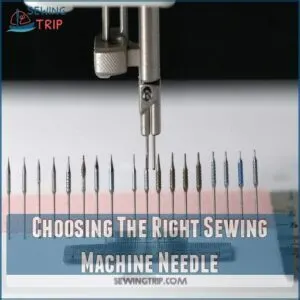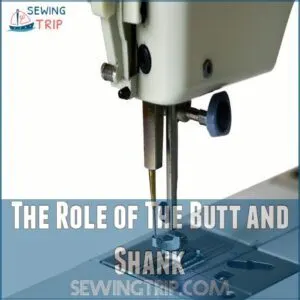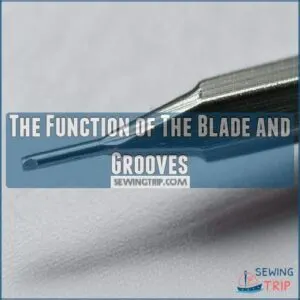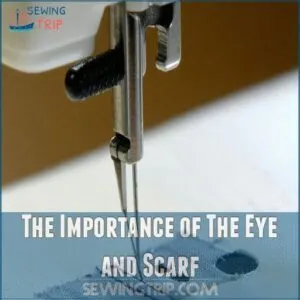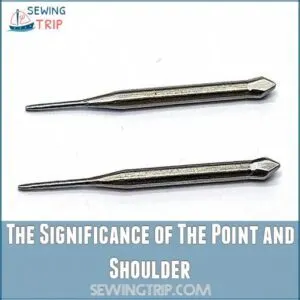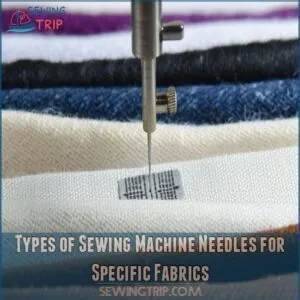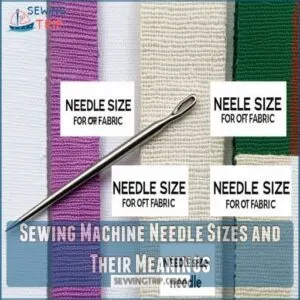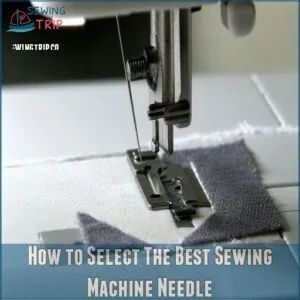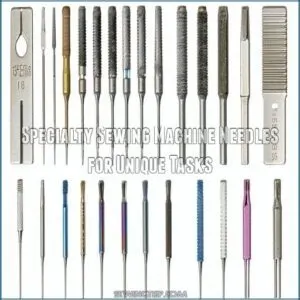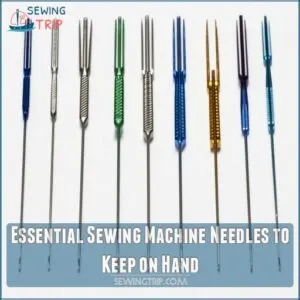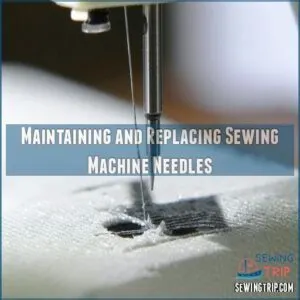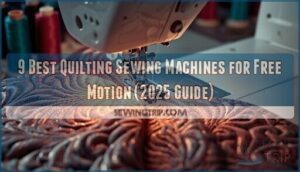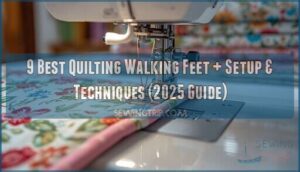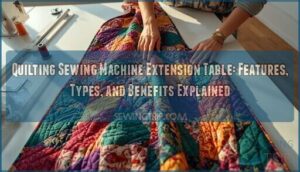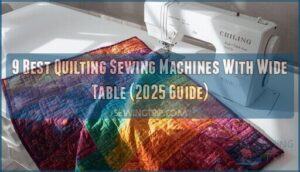This site is supported by our readers. We may earn a commission, at no cost to you, if you purchase through links.
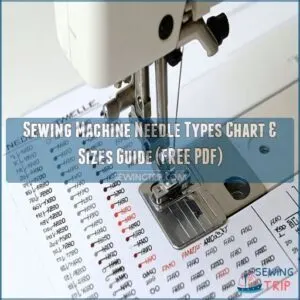
You’ll discover a sewing machine needle types chart guides you through this fascinating labyrinth.
From universal needles, your trusty "Swiss Army knife" for general sewing, to jeans/denim needles that bulldoze through thick fabrics, it’s all about matching the right needle to your fabric.
Leather needles make stitching tough materials a breeze, while stretch needles tackle those finicky fabrics like jersey.
Don’t forget ballpoint for knits or winged for decorative flair.
Knowing your needle types truly gives you the sewing edge.
Curious for more insider tips?
Keep exploring!
Table Of Contents
- Key Takeaways
- Choosing The Right Sewing Machine Needle
- Sewing Machine Needle Types Chart Explained
- Understanding Sewing Machine Needle Parts
- Types of Sewing Machine Needles for Specific Fabrics
- Sewing Machine Needle Sizes and Their Meanings
- How to Select The Best Sewing Machine Needle
- Specialty Sewing Machine Needles for Unique Tasks
- Are Sewing Machine Needles Universal and Interchangeable?
- Essential Sewing Machine Needles to Keep on Hand
- Maintaining and Replacing Sewing Machine Needles
- Frequently Asked Questions (FAQs)
- Conclusion
Key Takeaways
- You’ll find choosing the right sewing machine needle depends on fabric type and weight, ensuring smooth stitches and avoiding damage.
- A sewing machine needle types chart is essential for matching needles with fabrics and threads, preventing common sewing mistakes.
- Regularly checking and replacing needles enhances sewing performance; a worn needle can cause skipped stitches and fabric snags.
- Keep a variety of needle sizes and types, like universal and specialty needles, on hand to tackle any project efficiently.
Choosing The Right Sewing Machine Needle
Choosing the right sewing machine needle can feel like picking the perfect dance partner—it’s all about balance and compatibility.
You’ll want to keep in mind fabric weight and thread type to make sure your stitches are smooth and your sewing goes off without a hitch.
Considering Fabric Weight and Thread Type
Every fabric and thread combo can turn sewing into a joyful craft or a needle-filled nightmare.
Start by matching the fabric weight with the right needle type to prevent fabric damage.
Use thin needles for light materials, heavy ones for thick fabrics.
Choose thread weight wisely to guarantee stitch quality.
Remember these four steps:
- Identify Fabric Weight
- Choose Needle Size
- Consider Thread Type
- Adjust for Stitch Quality
Factors Affecting Needle Selection
So, you’ve matched your thread to your fabric weight. Great! Now, let’s talk needle size.
Understanding the nuances of needle numbers and colors can help you choose the right needle.
Needle size, fabric type, and thread size are a trio; get one wrong, and your stitches might look wonky.
A too-thin needle on heavy denim? Broken needle, guaranteed!
Too thick a needle on silk? Say goodbye to pristine fabric.
Use a needle size guide to avoid this sewing mishap!
Consider needle brand too; some brands run slightly differently.
Sewing Machine Needle Types Chart Explained
Cracking the code of sewing machine needle types can feel like sorting through a bustling marketplace, but a chart makes it simple.
Here’s how you can master it.
The sewing machine needle types chart is your treasure map, guiding you through the jungle of options for each fabric and task.
To choose the right needle, refer to a sewing machine needle chart to help you decide between universal, ball point, stretch, sharps, and quilting needles.
- Ease Your Worries: Say goodbye to fabric snags with the right needle.
- Match Made Easy: Pair needles effortlessly with your chosen threads using a clear chart.
- Avoid Pitfalls: Steer clear of common needle mistakes with concise guidelines.
- Maintenance Reminder: Always keep needle maintenance tips handy to prolong use.
With this chart, you’ve got the tool you need to make sewing as smooth as butter!
Understanding Sewing Machine Needle Parts
When you start understanding the parts of a sewing machine needle, like the butt, shank, eye, and scarf, everything begins to sew together beautifully.
Think of it like knowing the secret ingredients in your grandma’s famous pie—each part has a special role that’s essential for a flawless stitch.
The Role of The Butt and Shank
A solid foundation begins with understanding the butt and shank of sewing machine needles. These parts provide stability and compatibility. The butt helps position the needle, while the shank provides grip, fitting snugly into your machine. Keep an eye on shank length for top performance!
| Feature | Function | Importance |
|---|---|---|
| Butt | Positions needle | Makes sure needle fits |
| Shank | Provides grip, adds stability | Enhances control |
| Compatibility | Matches machine specifications | Prevents misalignment |
| Functionality | Ensures smooth sewing | Minimizes needle breaks |
| Stability | Reduces wobble during use | Promotes even stitching |
The Function of The Blade and Grooves
Right after you’ve got the butt and shank, let’s talk blade and grooves—the heart of needle functionality.
Picture grooves as tiny highways for thread flow, ensuring smooth stitches and great stitch quality.
Meanwhile, the blade adds durability.
Here are four benefits:
- Promotes precise stitching
- Enhances thread flow
- Boosts stitch quality
- Improves needle durability
The Importance of The Eye and Scarf
Just as the blade and grooves guide the stitch, the needle eye and scarf are key players too.
The eye shape affects thread passage, keeping your sewing smooth and minimizing thread wear.
The scarf creates space for the stitch to form properly.
Remember, understanding sewing needle types and sizes empowers you to master your crafting game effortlessly!
The Significance of The Point and Shoulder
The point and shoulder of a sewing machine needle are pivotal in ensuring seamless stitching. The point’s sharpness pierces fabric effortlessly, while the shoulder size impacts thread stability.
- Point Sharpness: Affects fabric penetration.
- Shoulder Angle Effect: Influences stitch tension.
- Needle Size Relation: Matches needle type to fabric weight.
Explore these elements to master sewing needle types.
Types of Sewing Machine Needles for Specific Fabrics
You’ll discover that different fabrics need different needles; choosing the right one prevents frustration and guarantees professional-looking results, so let’s explore the best needle types for various materials!
Universal Needles for General Sewing
You’ve explored the intricate parts of sewing machine needles.
Now let’s chat about universal needles—your go-to for everyday sewing adventures!
They tackle both woven and knit fabrics effortlessly, making them a staple in any sewist’s toolkit.
| Needle Size | Fabric Type | Brand |
|---|---|---|
| 70/10 | Light fabrics | Schmetz |
| 80/12 | Medium fabrics | Singer |
| 90/14 | Heavy fabrics | Janome |
| 100/16 | Denim or canvas | Klasse |
Ballpoint Needles for Knit Fabrics
Tired of snagging your knit fabrics? Ballpoint needles are your go-to solution.
Instead of piercing, they glide between fibers, making them perfect for all knit fabric types.
Choose the right ballpoint needle size based on your fabric’s thickness.
Brands like Schmetz offer options that excel in durability and precision.
Proper care keeps your knit projects looking professional.
Sharp Needles for Straight Lines and Delicate Fabrics
Sharp needles slice through fabric like a well-honed blade, perfect for straight lines and delicate fabrics.
They’re your go-to for maintaining stitch quality on lighter materials like silks or chiffon, ensuring each stitch is precise.
Remember, matching needle size with fabric type is important—check that sewing needle chart!
Pay attention to needle care for excellent results.
Specialty Needles for Leather, Denim, and Stretch Fabrics
Diving into thick fabrics like leather or denim? You’ll need the right tools—specialty needles!
Leather needles, with their cutting point, slice through tough material smoothly.
Denim needles boast strength for heavyweight fabrics.
For stretchy materials, grab stretch needles that flex as needed.
Different fabrics call for these specific tips from trusted sewing machine needle brands.
Sewing Machine Needle Sizes and Their Meanings
In sewing, choosing the correct needle size is like finding the perfect dance partner—it needs to match the fabric’s weight and mood.
European and American needle sizes can be confusing,
but once you understand them, you’ll be stitching like a pro without missing a beat.
European Vs American Needle Sizes
When it comes to sewing machine needles, size matters just like choosing the right tool for a job.
European sizes are measured in millimeters, offering precision.
Meanwhile, American sizes come in simpler numbers.
To make sure the right fit, matching the needle size to the fabric weight chart is important for smooth stitching and preventing fabric damage.
No need to stress, here’s your quick needle size conversion guide:
- European: 75/11
- American: 11
- Consider: Thickness
- Remember: Fabric type
Choosing The Right Needle Size for Your Fabric
So, you’ve got the European and American needle size systems down pat.
Now, let’s match needle size to your fabric.
Think of it like this: lightweight fabrics need thinner needles, preventing holes.
Heavier fabrics need stronger needles for a smooth stitch.
The right needle size guarantees perfect stitch quality, no matter your thread type or needle brand.
Get it right, and you’re golden!
How to Select The Best Sewing Machine Needle
Choosing the best sewing machine needle might seem like threading a needle in the dark, but it’s key to perfect stitches.
Consider the fabric weight and thread type, matching the needle size with the fabric’s thickness, to avoid a sewing disaster that looks like your cat got to your project first.
Considering Thread Weight and Type
When considering thread weight and type, choose carefully for perfect stitches.
Picture it like pairing wine with cheese: they need to complement each other.
For best results, select from various sewing needle types, such as those found in a sewing needle shop.
Here’s a quick guide:
- Thread Tension: Match thread size to tension settings.
- Thread Type Compatibility: Use compatible threads to avoid tangling.
- Stitch Quality: Make sure thread weight enhances stitch.
Perfect pairings? Stitch magic!
Matching Needle Size to Fabric Thickness
Choosing the right needle size is like finding the perfect dance partner for your fabric.
Thick fabrics, meet your hefty needle.
Lightweight materials? A smaller gauge will do without causing needle breakage or sewing machine issues.
Stitch quality improves with the right pair-up, especially when considering the fabric weight and needle size guidelines to avoid skipped stitches, thread breakage, and fabric puckering.
| Fabric Weight | Needle Gauge | Common Issues |
|---|---|---|
| Light | 60-70 | Skipped stitches |
| Medium | 80-90 | Standard quality |
| Heavy | 100-110 | Needle breakage |
Specialty Sewing Machine Needles for Unique Tasks
When tackling unique sewing projects, specialty needles are your secret weapon for success.
Whether you’re working with metallic threads for embroidery or need stretch needles for knit fabrics, having the right tool makes all the difference!
Metallic Needles for Embroidery and Decorative Stitches
Got a flair for embroidery? Metallic needles are your go-to, designed to tackle shiny threads without a hitch, especially when paired with a reliable embroidery machine featuring automatic needle threaders and user-friendly interfaces like those in best sewing and embroidery machines.
These specialized embroidery needles have a larger eye to accommodate heavier thread weights, boosting stitch quality.
They’re essential for achieving those intricate decorative stitch effects.
Grab a sewing needle types chart, find your ideal needle size, and let your creativity shine!
Stretch Needles for Knit and Stretch Fabrics
Stretch needles are your secret weapon for knit and stretch fabrics.
They glide through fibers without snagging, ensuring perfect stitches.
Brands like Schmetz or Singer offer various sizes suited for different fabric weights.
Remember not to mix a fine needle with heavy knits.
Use the sewing needle chart to choose the right size, and watch your projects shine!
Are Sewing Machine Needles Universal and Interchangeable?
While many sewing machine needles look similar, they aren’t all created equal.
Understanding needle compatibility is key to preventing broken needles and frustrating sewing mishaps.
You’ll learn about the factors that affect whether or not needles are interchangeable, ensuring your sewing projects go smoothly.
Understanding Needle Compatibility
Every sewing enthusiast knows needle compatibility isn’t universal. Here’s what to remember:
- Needle Brands Vary: Different brands might lead to unexpected stitches.
- Size Matters: Your sewing machine needle sizes can affect performance; check a needle size comparison chart before you start.
- You can browse various sewing machine needle options from different brands, such as sewing machine needles online, to find the one that suits your machine.
- Machine Brand Influence: Verify requirements for specific sewing machine brands.
- Use Compatibility Charts: A sewing machine needle chart or a needle compatibility chart helps match your needle to your machine perfectly.
Factors Affecting Needle Interchangeability
Needle compatibility isn’t just about fitting in your machine.
Fabrics and sewing machine brands also come into play.
If you’re wondering how it all connects, check out this quick guide:
| Factor | Consideration |
|---|---|
| Sewing Brand | Brand-specific design |
| Thread Type | Thickness and material |
| Point Shape | Fabric piercing method |
| Needle Size | Fabric weight compatibility |
Remember, the right needle helps you sew smoothly!
Essential Sewing Machine Needles to Keep on Hand
You’ll want to keep a variety of essential sewing machine needles on hand to tackle any project with ease and precision.
From Schmetz’s reliable universals to specialty options like the ballpoint for knits, having the right tool for the job can make all the difference—your fabric will thank you!
Brands of Sewing Machine Needles
For sewing machine needles, brands like Schmetz, Singer, and Janome stand out.
They’ve earned reputations for quality and innovation.
Whether you’re stitching denim or delicate silks, these brands offer diverse options at different price points.
Schmetz’s German precision is unmatched, while Singer delivers reliable versatility, making them staples in any sewing toolkit.
Needle Types for Common Sewing Tasks
You’ve got your needle brands stocked, but choosing the right type can turn your sewing project from frustrating to flawless!
Universal needles might handle everyday tasks, but specialty ones guarantee your stitches meet project needs smoothly!
Whether it’s handling heavyweight denim or delicate silk, having an arsenal of various needle sizes and types is key.
Maintaining and Replacing Sewing Machine Needles
Keeping your sewing machine in top shape includes knowing when to replace needles—no one enjoys surprises like skipped stitches or shredded fabric!
Regularly checking for signs of wear, like bent tips or strange noises, helps keep your sewing adventures smooth and frustration-free.
Signs of a Worn-Out Needle
Along with your sewing projects, keep an eye out for signs your sewing machine needles need replacing.
Thread breakage is a common clue, as are skipped stitches that leave your fabric looking a bit ragged.
Listen for those annoying popping sounds—that’s your needle screaming for help!
Bent needles are another issue; they’ll cause uneven stitches and potential fabric damage.
Don’t let a worn-out needle ruin your masterpiece. Regular checks save time and frustration.
How to Check and Replace a Needle
Spotting needle issues is like a detective story. You might hear snaps or see frayed threads.
To find the right needle, check out this helpful needle sizes chart
Solve the mystery by checking alignment. Lay the needle on a flat surface; unevenness means trouble. Remove it by loosening the clamp screw, then insert a fresh needle. This will make for smooth sewing and needle longevity. Your sewing needle chart will guide the proper replacement.
Frequently Asked Questions (FAQs)
What is a sewing machine needle size chart?
Did you know using the wrong needle size can ruin your project?
A sewing machine needle size chart guides you in matching needle sizes to fabric thickness.
This helps ensure smooth sewing and prevents skipped stitches and fabric damage.
What is a sewing machine needle guide?
A sewing machine needle guide helps you choose the right needle for different fabrics and threads, ensuring smooth sewing.
It explains needle types, sizes, and uses.
This makes your sewing projects more precise and enjoyable.
Do sewing machines need different needle sizes?
Yes, sewing machines need different needle sizes to accommodate varying fabric thicknesses and thread types.
Choosing the right size guarantees smooth stitching and prevents issues like skipped stitches or fabric damage, enhancing your sewing projects’ quality.
What are the different types of sewing machine needles?
Ever wondered why your sewing machine acts up?
You’ll find universal, sharp, ballpoint, leather, twin, and embroidery needles, each designed for specific fabrics and projects.
Choosing the right one is key to flawless sewing!
How do I Choose hand sewing needle sizes & types?
Pick hand sewing needles by matching size and type to your fabric and task.
For delicate fabrics, use smaller needles like 10 or
Heavy materials need larger sizes, such as 4 or 6, ensuring smooth stitching.
What is the numbering system for sewing machine needles?
Sewing machine needles use two numbering systems: European sizes (metric) and American sizes.
European numbers denote needle diameter in tenths of a millimeter, while American numbers increase with needle thickness.
Matching the two guarantees precision.
What are the 7 different types of sewing needles?
Just as a chef selects the right knife, you choose from universal, ballpoint, sharp, embroidery, metallic, twin, and quilting needles.
Each has a unique purpose,
ensuring your stitching dances across fabric with precision and ease.
What is a 90-14 needle used for?
A 90-14 needle is versatile, tackling medium-weight fabrics like cotton, linen, and polyester with ease.
It’s perfect for clothes and home decor projects, striking a balance between strength and delicacy for reliable, smooth stitching.
How do I know which sewing machine needle to use?
Finding the right needle involves balancing fabric, thread, and purpose.
Use thicker needles for sturdy materials and finer ones for delicate fabrics.
Compatible thread and needle sizes guarantee smooth stitching, preventing skipped stitches and fabric damage.
What is the 80 12 needle used for?
You’re using an 80/12 needle for light to medium-weight fabrics like cotton and polyester.
It’s versatile, balancing strength and finesse, making it ideal for sewing clothes, quilts, or basic home projects.
Perfect for beginners and pros alike!
How often should sewing machine needles be replaced?
Think your needles are indestructible? Think again!
Replace them after every 6-8 hours of sewing, or sooner if you notice skipped stitches or thread breakage.
They’re cheap insurance for your projects.
What causes frequent needle breakage?
Frequent needle breakage happens due to using the wrong needle size for the fabric, needle defects, improper sewing machine settings, or high sewing speeds.
Make sure your needle and machine settings match your fabric and thread.
Can dull needles damage fabric?
Ever tried shaving with a rusty blade?
Dull sewing needles can snag threads, punch holes, or create uneven stitches, turning your fabric into a quilt of mishaps.
Replace them regularly to keep your projects smooth and flawless.
How to store sewing machine needles safely?
Store sewing machine needles in labeled containers or envelopes to sort by type and size.
Organize them by type and size.
Keep them in a cool, dry place to prevent rust.
Using a pin cushion or needle minder can also help organize and access them easily.
Are there eco-friendly sewing machine needles available?
Sustainable sewing sources sometimes stock eco-friendly needles, mainly crafted from bamboo or recycled materials.
They’re sturdier, less wasteful, and help green up your sewing space.
Go green, and stitch sustainability into your sewing story!
Conclusion
Discover the secrets of sewing mastery with the perfect sewing machine needle.
This sewing machine needle types chart is your roadmap to choosing the right needle for every project, big or small.
Whether you’re tackling a delicate knit or robust denim, matching needle to fabric guarantees flawless stitches.
Keep this guide handy and you’ll never needle in the haystack again.
Discover the joy of seamless sewing with confidence and precision, transforming your fabric into lasting creations.

